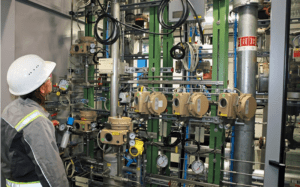Dow (Midland, Mich.) and Evonik Industries AG (Essen, Germany) announced the successful start-up and operation of a pioneering hydrogen peroxide to propylene glycol (HPPG) pilot plant at Evonik’s site in Hanau, Germany. Collaboratively developed by Dow, the world’s largest producer of propylene glycol, and globally leading hydrogen peroxide manufacturer Evonik, the plant uses the distinct HYPROSYN method to enable the direct synthesis of propylene glycol (PG) from hydrogen peroxide and propylene.

Evonik and Dow’s HPPG pilot plant (Source: Dow)
“At Dow, we believe in collaborating with our customers and other stakeholders to create, innovate and find solutions to big challenges. So, I am delighted to see this plant become operational through this collaboration,” said Andrew Jones, global business director for Chlor-Alkali Vinyl & Propylene Oxide, Propylene Glycol, at Dow. “With this innovative technology and flexible asset and business model, we are well positioned to meet our customers’ needs and growing market demand.”
“At Evonik Active Oxygens, we put sustainability at the core of futurizing our business. This relies not only on innovative technologies, but also the ability to scale these up and bring them to market,” remarked Michael Träxler, head of Evonik’s Active Oxygens business line. “That’s where excellent strategic partnerships come into play. The startup of this pilot plant in Hanau thus not only represents a major technological milestone in our efforts to make
industry more sustainable, it is also a prime example of how cross-company collaboration, like this partnership with Dow, is essential to driving sustainable solutions.”
The pilot plant will demonstrate the benefits of the novel technology. In contrast to the traditional process, where propylene is used to make propylene oxide (PO), which is converted to PG through hydrolysis, the HYPROSYN® process uses a novel catalytic system to generate PG directly from propylene and hydrogen peroxide. The integration of all key reaction stages in a single reactor eliminates the need of additional investments in PO capacity and lowers capital requirements. The process also enables a reduced environmental footprint e.g., water consumption is reduced to less than 5% compared to conventional PG methods. In addition, existing PG plants can be retrofitted to benefit from
this new technology.
Propylene glycol serves as an essential ingredient such as a high-performing additive, intermediate, or initiator in a wide range of applications — including industrial, food and animal feed, pharmaceuticals, and cosmetics. Over the next few years, the Dow and Evonik teams will continuously evaluate the plant’s operations and capabilities to scale up manufacturing, in support of growing market demand.